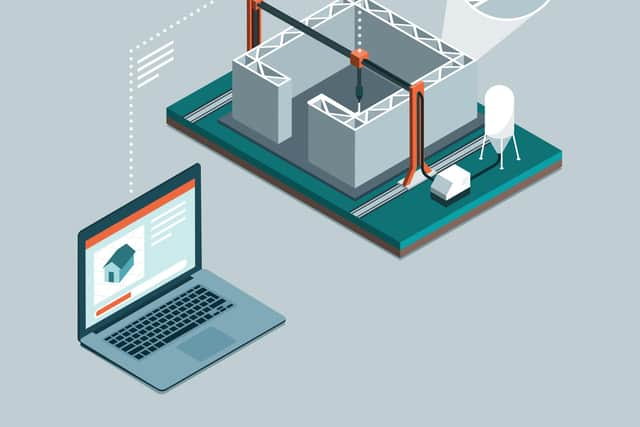Another dimension: Kirsty McLuckie on 3D printed homes
The automotive industry already uses 3D printing to create low-cost parts and prototypes, and the pace of technological advance means it might not be long before fully 3D printed cars are available.
Aerospace parts, components used in wind turbines, and fire-fighting drones are also manufactured using this kind of printing, while medical prosthetics and dental implants have long used the technology to produce computer-aided precision fits.
Advertisement
Hide AdAdvertisement
Hide AdAnd building a whole house by printing out a concrete structure, layer by layer, has already been achieved.


In 2018, a family in France became the first to move into a 3D dwelling, which was built as a prototype for larger projects. The family concerned had been living in social housing before being chosen to move into the groundbreaking four-bedroom home.
The house took 54 hours to print, followed by four months of contractors adding finishing touches. In total, the cost was £176,000, coming in at 20 per cent cheaper than an identical construction using trad methods.
Last year saw the first sale of a 3D printed house take place in the Netherlands. And a small town in Virginia US will become the site of 200 such houses built over the next five years, using a massive 19-ton robotic printer.
Dubai has announced an aim of constructing 25 per cent of all new homes using 3D printing by 2025.
It is a method of construction that is increasingly attracting interest in the UK, where housing is at such a premium.
A scientific paper, published by the Institute of Physics, details cost breakdowns on house construction in the UK, and looked at the viability of 3D technology in reducing house prices. It estimated that the 3D printing of walls and foundations would generate savings of up to35 per cent in materials and labour.
So 3D printed houses look like an attractive option, in terms of costs and time, and could be one way to alleviate the housing crisis and help more people buy affordable homes – the 3D method can also utilise cheaper materials.
Advertisement
Hide AdAdvertisement
Hide AdSome more eco-friendly versions are constructed using natural materials, such as mud from the locale, as well as waste materials.
There is naturally less wastage with 3D printing, compared to normal construction, because everything is printed true to size – making it more economically and environmentally friendly.
But there are drawbacks – 3D houses are only estimated to last around 50-60 years, as many have timber elements that are more susceptible to decay over time if not treated or maintained properly.
At the moment, 3D printed houses are mostly still at the planning stage in the UK. However, with big concerns such as Ikea backing the movement, it may not be long before they become widely available.
Whether or not you choose to wear 3D printed clothes – first showcased by Karl Lagerfeld in 2015 – or create meals from 3D printed food, another innovation, while in your printed home is up to you.
- Kirsty McLuckie is property editor at The Scotsman
